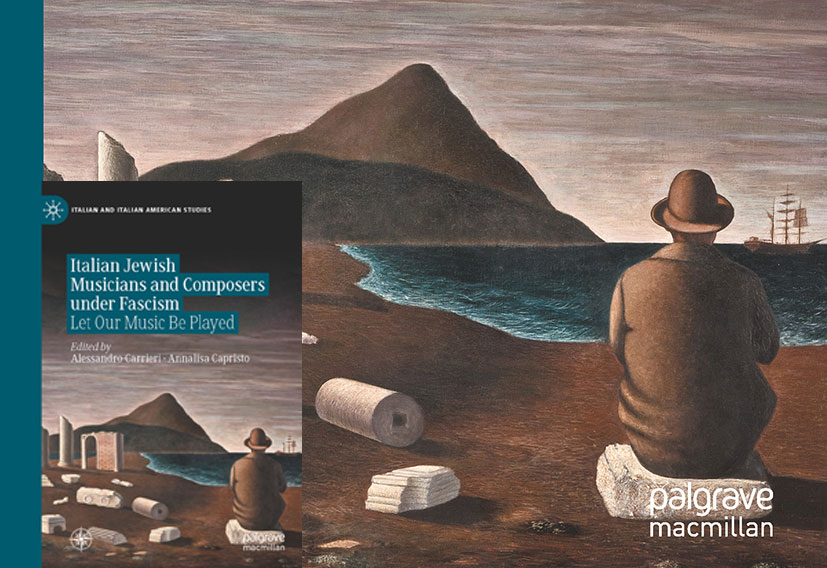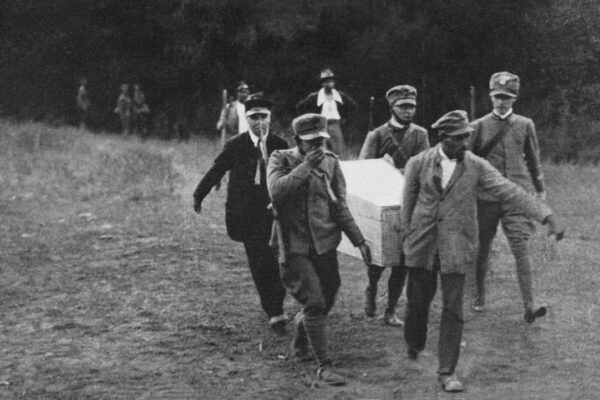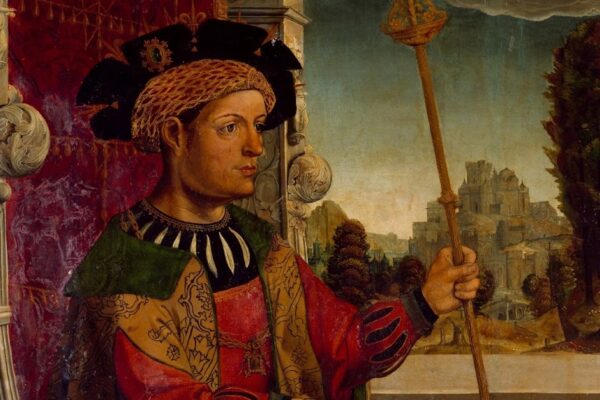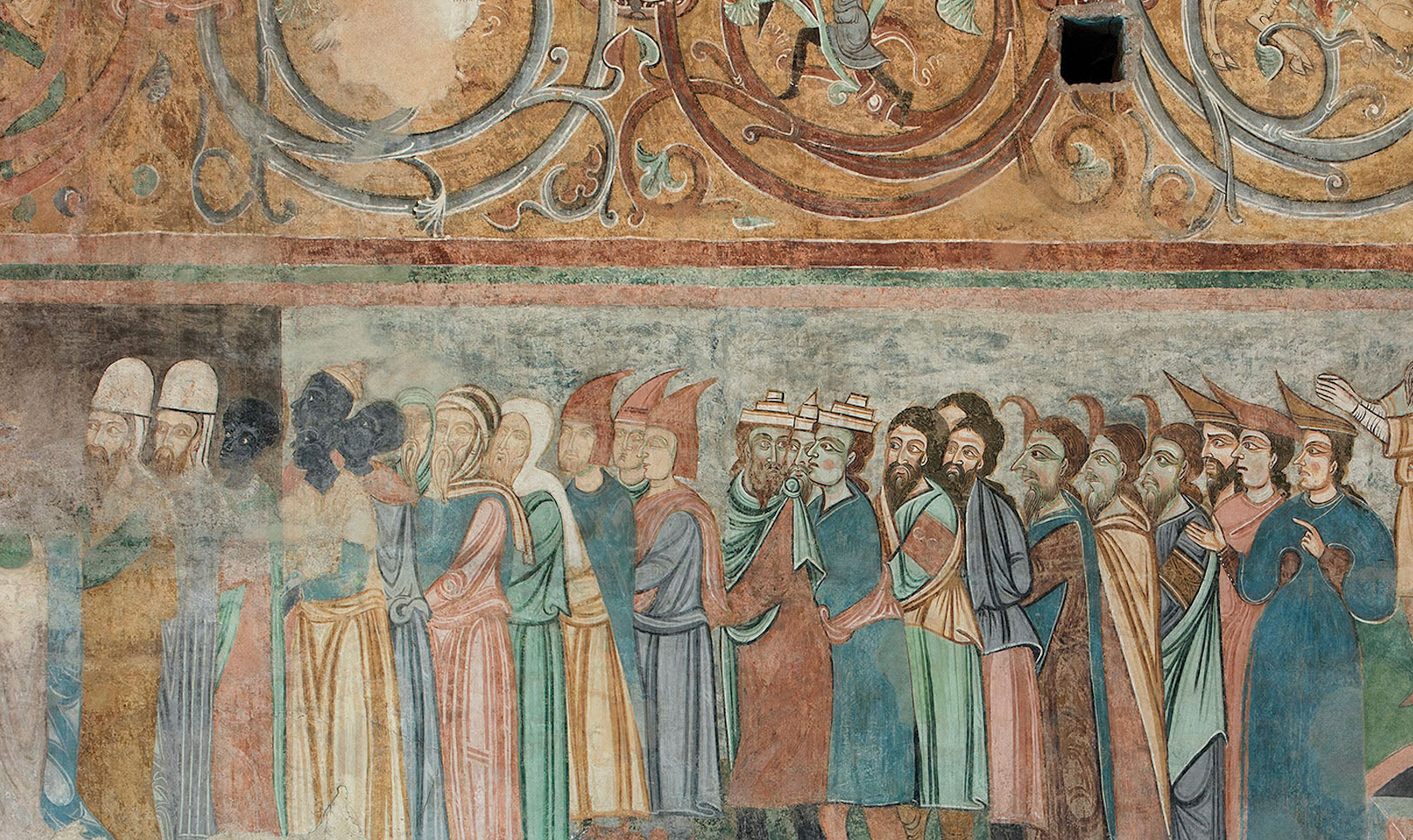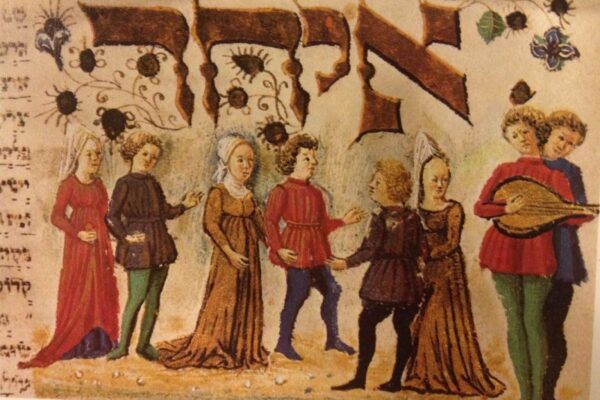The disproportionate impact (despite all of today’s technology and social media) of the current pandemic on musicians and performers is a pale indication of what it means —creatively, financially, and psychologically— when circumstances prevent musicians from making music, that is, to exist in their primary capacity. This warrants special attention to the devastating blow to Jewish musicians in Fascist Italy starting in the Fall of 1938. On November 17 of that year, the Royal Law Decree N.1728 imposed “the dismissal of every Jewish employee in theaters, music, cinema, and radio,” which meant that works of Jewish authors disappeared from theaters, as well as in radio music shows. By June 1940, “any entertainment activity in the show business” was banned to people of the “Jewish race.”
Italian Jewish Musicians and Composers under Fascism–Let Our Music Be Played, (Palgrave, Macmillan 2021), edited by Alessandro Carrieri and Annalisa Capristo, is a long-overdue comprehensive overview of how Mussolini’s anti-Semitic legislation aimed to abruptly put an end to the careers of Italian and foreign Jewish musicians (composers, singers, instrumentalists) living in Italy. In highlighting the specificity of the work of musicians in times of State persecution, the essays in the book also allude to the cultural impoverishment that the silencing of Jewish musicians caused the country, and more in general, to the incalculable comfort, consolation, diversion and sheer joy that music of all kinds provides in times of duress.
Well researched, thought-provoking and highly informative, this collection of essays, organically conceived, outlines a sub-category in the vast literature about Mussolini’s anti-Semitic persecution. The book restores dignity and knowledge about creative artists who underwent persecution, marginalization, and often exile, and whose works were silenced by the dictatorship for seven years.
Italian Jewish Musicians and Composers under Fascism comprises eight essays, alternating emblematic case studies to more general overviews, with various research stiles and multidisciplinary approaches. Without giving away the wealth of new research and often startling discoveries, each essay warrants a short description.
The opening essay, Forms and Methods of Anti-Jewish Persecution in Fascist Italy from 1938 to 1943 by Michele Sarfatti, photographs with keen precision the hardship to which Jews living in Italy were subjected at the time of the implementation of the Racial Laws of 1938 and the steps that got them there. It then follows the tragic developments into 1943. The essay provides the reader with the historical background against which the individual stories of the musicians featured in the book unfold.
Luca Lévi Sala’s Cultural Cleansing in Italian Music Criticism in the Early 1930s: Autarchy, Eugenics and Anti-Semitism, focuses on the bias much of the music criticism of the ’30s held toward Jewish musicians. Criticism often fomented cultural intolerance and racism even before the Racist Laws and, like other example of cultural bias, paved the way for their later acceptance. The author describes the crescendo of virulent violence of certain Fascist cultural movements as early as 1932. Soon, major composers such as Alfredo Casella— who in the 1920s had championed the musical innovations of Schönberg, Stravinsky, Weill, Milhaud, Honegger, Bartók— followed suit. In a letter to Pierre Schaffner, Casella wrote, “[…] In Italy today we make good and authentic national music, we owe it to our past and not to foreign contaminations which are by now incompatible with our spirit. […]”
Music critics and intellectuals such as Curzio Malaparate wrote with unmitigated bluntness, nonsense such as “The only original and powerful artistic expression of Fascism is Mussolini himself,” creating a “climate” in which openly anti-Semitic cultural attacks progressively became the norm.
Writing about the progressive marginalization and exclusion of Jewish musicians from the national discourse Lévi Sala, makes an import point— which applies to the entire subject of the book—of how Fascists’s cultural bigotry and racism developed independently of pressure from Nazi Germany: “Recent studies have demonstrated that Fascist anti-Semitism was not something ultimately detected in the German directives nor directly influenced by German racist propaganda.” Music criticism became an instrument of the Regime’s propaganda and —as Lévi Sala explains—(its) political essence (…) was strongly aligned with the rhetorical techniques and styles of Fascism.”
In Jazz in Fascist Italy: Social Impact, Politics, and Racism, Camilla Poesio explores the impact of jazz, the new American popular music, on a country caught between fascination and scorn toward the United States. In her compelling essay, Poesio explores the ambiguities between the Regime’s official line and the popular appeal of jazz and American cinema.
“In Italy, jazz appeared later, at the beginning of the 1920s, that is, upon the establishment of the Fascist Regime. Therefore, studying jazz in the 1920s, 1930s, and 1940s meant studying jazz during the fascist era. If jazz in Berlin was “roaring” during the Weimar Republic, the situation in Italy could not have been more different.” Since the 1920’s jazz arrived in Italy through a wide variety of channels, including the burgeoning record industry, American film soundtracks, bands performing on steeamliners between Italian ports and New York, the radio, Italian immigrants in the US sending recordings, as well as the interest of intellectuals such as the novelist Cesare Pavese, who rapidly became a jazz fan and saw in that music a gateway to American culture.
“Being rooted in Italy as a primarily urban phenomenon, the diffusion of jazz, from the 1920s, was closely linked to tourism and to some holiday destinations. Therefore, it is possible to find a link between tourism (especially luxury tourism, largely American), jazz, and opulent hotels. A significant case study was Venice. Many American tourists lived for some weeks in the smartest-set hotel in Europe—the Excelsior Palace Hotel. They brought in their suitcases not only fancy dresses and eccentric hats but also many jazz discs. The hotel offered every comfort and every kind of entertainment: a huge terrace where the guests skated, four tennis courts, one beach resort, horse races, and the largest and most popular Kursaal in Italy, where the tourists danced jazz all through the night.”
The attitudes of the Fascists toward jazz shifted over the years and mirrored the vicissitudes of the Regime. Between 1921 and 1929, “Fascism showed its most violent face in order to establish itself. In this phase, jazz was fundamentally deprecated.” The international crisis of 1929 accelerated the narrow-minded view that only Italian music should be performed, thus cutting opportunities for American jazz bands.
Despite the Fascists’ attempt to condemn and repress jazz, Poesio points out how the great need for escapism and entertainment during the years of dictatorship created a real (if often underground) appetite for jazz and Afro-American rhythms. However, following the Italian aggression on Ethiopia came a phase in which jazz was seen as negro music, thus inferior if not alien and dangerous. In 1938, the Racial Laws further marginalized jazz, and in 1941, the United States’ entry into the war prompted the labeling of jazz as “enemy music”. At last, during the war years 1943-44, the arrival of the Allies brought to Italy the so-called Victory discs and jazz gained instant popularity.
On of the book’s central and most compelling essays is Annalisa Capristo’s La Scala, the Jews and Erich Kleiber: An Anti-Semitic Episode of December 1938.
Using archival sources and media clips, Capristo reconstructs the watershed moment when, in 1938, the internationally renowned Austrian conductor Erich Kleiber, upon learning that the newly promulgated Racial Laws would prevent Jews from attending concerts, refused to conduct Beethoven’s Fidelio, at La Scala in Milan. Kleiber’s courage, the international resonance of his act, the reaction in the Fascist press are all analyzed in detail against the backdrop of the historical events that lead up to the racial legislation. Adopting Raul Hilberg’s category of “onlookers” or “bystanders,” Capristo moves away from the binary opposition between victims and perpetrators. She analyses what occurred in Italy’s musical life, encompassing those who, upon the promulgation of the Laws, were forced to take a stance: colleagues, teachers, pupils, critics, and the public of the persecuted Jewish musicians.
“On December 30, The Washington Post, whose source was the United Press news agency, reported the incident in an article entitled “Kleiber Quits La Scala Over Aryan Issue: Noted Opera Leader Objects to Milan’s ‘Anti-Semitism.'” The newspaper reported that Kleiber had written a harsh letter to the Milanese theatre explaining his withdrawal. “I have just learned that the doors of La Scala Theatre will be closed to your Jewish fellow citizens”—the conductor explained to La Scala management, immediately adding that: “music is made for everyone, like the sun and the air. When this fountain of consolation, so necessary in these hard times, is denied to any human being— and merely because he belongs to a different religion and race—I cannot collaborate either as a Christian or as an artist. Jewish patrons were to show up at La Scala box office the following Sunday and be subjected to the humiliating procedure of returning their season tickets, obtaining reimbursement of the tickets that had been purchased at a previous date.”
Capristo’s detailed reconstruction of the events, in light of recently, emerged new documents also highlights the position of the highest Vatican officials, including the Secretary of State and future Pope, Pacelli, and Domenico Tardini, the Secretariat of State for Extraordinary Affairs. The Vatican, whose only intervention on the Racial Laws concerned its claim of jurisdiction on mixed marriages, did not deem objectionable the exclusion of Jews (musicians and audience) from Italian cultural life.
Alessandro Carrieri’s in Music in Transit: The Exile of Italian Jewish Musicians from Fascist Italy, compares and contrasts the exiles of pianist Gualtiero Volterra to Australia and composer Renzo Massarani to Brazil, addressing the complex question of how in each case, exile impacted their creativity. A return to music marked Gualtiero Volterra’s experience of exile —“He had ceased his work as a pianist in the 1930s, resuming it successfully during his exile in Australia”. For Massarani, on the other hand, exile signified a near-total abandonment of his work as a composer and the refusal to allow any performance of his music written before his departure from Italy.
Carrieri writes: “I have chosen these two musicians as case studies for two reasons: both are curiously under-researched, and each had vastly divergent experiences of exile, with Volterra eventually returning to Italy and Massarani remaining in Brazil. The life and music of Volterra have almost entirely been ignored by academia, while Massarani has been the subject of a few scholarly articles. However, these articles focus in large part on Massarani’s life before his departure for Brazil, rather than his exile.” While the bulk of his essay is on Volterra and Massarani, Carrieri also describes aspects of the exiles of two better-known composers, Mario Castelnuovo Tedesco and Vittorio Rieti, both of whom had found refuge in the United States. Hopefully, Carrieri’s research on Volterra and Massarani and their experiences in exile may lead to further investigations into their music.
Raffaele Deluca’s contribution to this collection “Wir treffen uns am Schluss” (We Shall Meet at the End)—Kurt Sonnenfeld (1921–1997) at Ferramonti: The Persecution, the Exile, the Internment, The music, touches on yet a different aspect: the experience of foreign Jews trapped in Mussolini’s internment camps. Deluca focuses on the musical output of the Viennese Jewish composer Kurt Sonnenfeld, who spent four years and eight months in the internment campo of Ferramonti di Tarsia, in a remote area of Calabria. Sonnenfeld was among the few internees who remained at Ferramonti almost for the entire existence of the camp up to the arrival of the Allies. The composer’s arrival in Italy resembles that of many German and Austrian Jews. After the Anschluss, in 1938, the Nazis shut down the Vienna Conservatory where he was studying, and Sonnenfeld’s parents allowed him to move to Milan. They hoped that from there, he could eventually reach the US. Their hopes, though well-founded, did not pan out: on February 1, 1941, he was arrested, sent to the local prison for a few weeks; he was then taken to Ferramonti, where he remained from February 19, 1941, until September 1944. Despite the dreadful conditions of the camp, Deluca chronicles in detail how Sonnenfeld connected to fellow interned musicians. In Ferramonti, he “had the totally unexpected opportunity to meet professional musicians and continue studying music. Very close to him were the Croatian cellist and orchestral conductor Lav Mirski (1893–1968), former cellist in the Wiener Concertverein and then director of the National Theatre in Osijek; the Polish pianist Bogdan Daniel Zins (1905–1994); the Ukrainian composer Isak Thaler (b. 1902), the Bosnian pianist Ladislav Sternberg (1914–1984), German baritones Sigbert Steinfeld (b. 1909) and Paul Gorin (1916–1992). Also interned in the camp were some younger musicians similar in age, for example the Serbian composer Leon Levitch (1927–2014), who later settled in Los Angeles and went on studying composition with Mario Castelnuovo-Tedesco and Darius Milhaud. Lav Mirski, in particular, was soon considered as a sort of spiritual leaderin the camp. He was to be the Kapellmeister, able to reconstruct a new cultural identity even in those conditions.”
Without sugar coating life at Ferramonti, a harsh camp with scarce food and terrible sanitary conditions, Deluca describes Sonnenfeld’s and the other musicians/internee’s resourcefulness and willpower. After the liberation, Sonnenfeld settled in Milan, refusing to return to Austria, where his parents and most of his family had been murdered.
The concluding essay by Erik Levi, An Expedient Alliance? Musical Relationships Between Nazi Germany and Fascist Italy in the Period Between 1933 and 1945 investigates through original research and new documents the complex, bumpy relationship in the music field between Fascist Italy and Nazi Germany. The political and later military alliance between the two regimes was not enough to smooth the many difference in the approach, style, and enforcement of cultural directives. Yet, Levi argues “music and cooperation regarding its control was a fundamental component of both regimes.”
One of Levi’s reference point is Benjamin G. Marin, whom he quotes: “The most significant driving force to pull the two countries ever closer together was a shared desire to usurp the liberal internationalism that had prevailed in other Western European countries since the end of the First World War. Even before the signing of the cultural agreement between the Axis powers, Martin argues that “German and Italian cultural officials had begun to see each other as partners in a common project of cultural revisionism, forging a revolutionary alliance against the hegemony of the liberal-democratic vision of European civilization.” Over the years, the balance of power shifted from Mussolini’s cultural establishment, dominant until 1936, to the Nazi’s quick take over in the years to follow.
Italian Jewish Musicians and Composers under Fascism–Let Our Music Be Played will appeal both to scholars and the general public with a wealth of information and insight into a lesser-known area of Fascist Jewish persecution. As Camilla Poesio points out: “Compared to the cinema, theater, painting, and literature, music was one of the arts the Fascist regime focused on and engaged with less.” Thus it is not surprising that it took so long to uncover the different facets of exactly how political oppression affected not only Jewish musicians and audiences, but Italian musical life at large.


